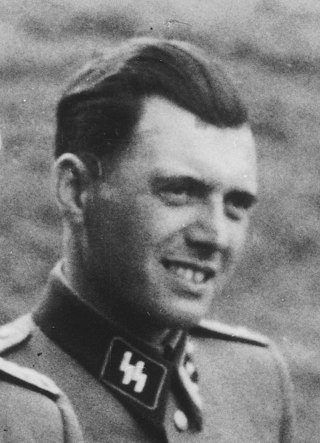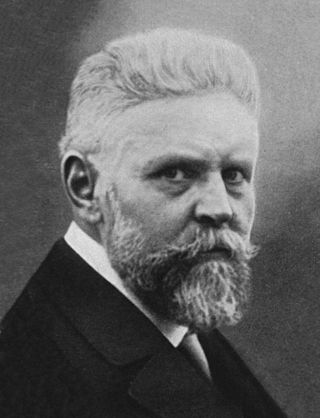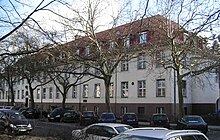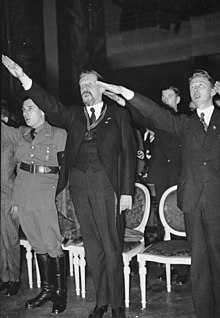
Josef Rudolf Mengele was a German Schutzstaffel (SS) officer and physician during World War II. Nicknamed the "Angel of Death", he performed deadly experiments on prisoners at the Auschwitz II (Birkenau) concentration camp, where he was a member of the team of doctors who selected victims to be murdered in the gas chambers, and was one of the doctors who administered the gas.

Rhineland Bastard was a derogatory term used in Nazi Germany to describe Afro-Germans, believed fathered by French Army personnel of African descent who were stationed in the Rhineland during its occupation by France after World War I. There is evidence that other Afro-Germans, born from unions between German men and African women in former German colonies in Africa, were also referred to as Rheinlandbastarde.

Eugen Fischer was a German professor of medicine, anthropology, and eugenics, and a member of the Nazi Party. He served as director of the Kaiser Wilhelm Institute of Anthropology, Human Heredity, and Eugenics, and also served as rector of the Frederick William University of Berlin.

The term racial hygiene was used to describe an approach to eugenics in the early 20th century, which found its most extensive implementation in Nazi Germany. It was marked by efforts to avoid miscegenation, analogous to an animal breeder seeking purebred animals. This was often motivated by the belief in the existence of a racial hierarchy and the related fear that "lower races" would "contaminate" a "higher" one. As with most eugenicists at the time, racial hygienists believed that the lack of eugenics would lead to rapid social degeneration, the decline of civilization by the spread of inferior characteristics.

Otmar Freiherr von Verschuer was a German-Dutch human biologist and geneticist, who was the Professor of Human Genetics at the University of Münster until he retired in 1965. A member of the Dutch noble Verschuer family, his title Freiherr is often translated as baron.

The Kaiser Wilhelm Society for the Advancement of Science was a German scientific institution established in the German Empire in 1911. Its functions were taken over by the Max Planck Society. The Kaiser Wilhelm Society was an umbrella organisation for many institutes, testing stations, and research units created under its authority.

Ernst Rüdin was a Swiss-born German psychiatrist, geneticist, eugenicist and Nazi, rising to prominence under Emil Kraepelin and assuming the directorship at the German Institute for Psychiatric Research in Munich. While he has been credited as a pioneer of psychiatric inheritance studies, he also argued for, designed, justified and funded the mass sterilization and clinical killing of adults and children.

Alfred Ploetz was a German physician, biologist, Social Darwinist, and eugenicist known for coining the term racial hygiene (Rassenhygiene), a form of eugenics, and for promoting the concept in Germany.
Fritz Gottlieb Karl Lenz was a German geneticist, member of the Nazi Party, and influential specialist in eugenics in Nazi Germany.

The German Society for Racial Hygiene was a German eugenic organization founded on 22 June 1905 by the physician Alfred Ploetz in Berlin. Its goal was "for society to return to a healthy and blooming, strong and beautiful life" as Ploetz put it. The Nordic race was supposed to regain its "purity" through selective reproduction and sterilization. The society became defunct after World War II.

Nazi eugenics refers to the social policies of eugenics in Nazi Germany, composed of various ideas about genetics which are now considered pseudoscientific. The racial ideology of Nazism placed the biological improvement of the German people by selective breeding of "Nordic" or "Aryan" traits at its center. These policies were used to justify the involuntary sterilization and mass-murder of those deemed "undesirable".
Wolfgang Abel was an Austrian anthropologist and one of Nazi Germany's top racial biologists. He was the son of the Austrian paleontologist Othenio Abel.
Homo Sapiens 1900 is a 1998 Swedish documentary film directed by Peter Cohen, about various eugenics methods that were in practice in Europe during the first part of the 20th century.
The Max Planck Institute of Psychiatry is a scientific institute based in the city of Munich in Germany specializing in psychiatry. Currently directed by Elisabeth Binder and Alon Chen, it is one of the 81 institutes in the Max Planck Society.
Karl Astel was an Alter Kämpfer, rector of the University of Jena, a racial scientist, and also involved in the German Nazi Eugenics program.
Hans Fleischhacker was a German anthropologist with the Ahnenerbe and a commander in the SS of Nazi Germany. He worked with Bruno Beger on some projects, making measurements of Jewish people. He was with Beger at Auschwitz when the people were selected to be part of the Jewish skull collection, a project of the Ahnenerbe. At their post-war trial, Beger was found guilty of full knowledge of the scope of that project, while Fleischhacker was found not to be aware that the purpose of the measurements was to select the 86 people to be murdered at Natzweiler-Struthof camp.
The history of eugenics is the study of development and advocacy of ideas related to eugenics around the world. Early eugenic ideas were discussed in Ancient Greece and Rome. The height of the modern eugenics movement came in the late 19th and early 20th centuries.
Karin Magnussen was a German biologist, teacher and researcher at the Kaiser Wilhelm Institute of Anthropology, Human Heredity, and Eugenics during the Third Reich. She is known for her 1936 publication Race and Population Policy Tools and her studies of heterochromia iridis using iris specimens, supplied by Josef Mengele, from Auschwitz concentration camp victims.

Peter Emil Becker was a German neurologist, psychiatrist and geneticist. He is remembered for his studies of muscular dystrophies. Becker's muscular dystrophy and Becker myotonia are named after him. Since 1998, the Gesellschaft für Neuropädiatrie (GNP) grants Peter-Emil-Becker-Preis for special achievements in the field of child neurology.

The Training Institute of the Deaf in Berlin-Neukölln was founded in 1788 as a school for the deaf. Some German schools had been founded by educators trained in France by Abbé de l'Épée. The common view at the time was that the deaf were uneducable; they were even feared and shunned. L’Épée's school, students, and disciples helped to change that view. The Paris school, which had been founded by the Abbé Charles Michel de l'Épée in 1771, was using French Sign Language in combination with a set methodically developed signs. During l’Épée's lifetime, many schools were founded throughout Europe that were modeled on his teaching methods. Other German schools, such as the institute, were founded on the principles and methods of Oralism. Oralism is the idea that the Deaf should learn to speak in order to appear normal with the non-Deaf world, it became predominate in German schools. In 1811, this school became a training institute for teachers. Students from all over Prussia were sent here to receive training.














